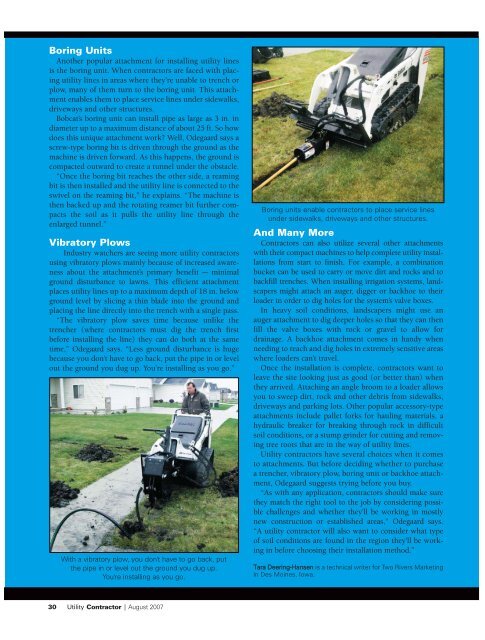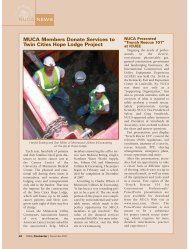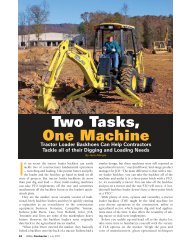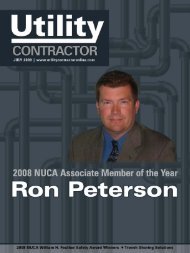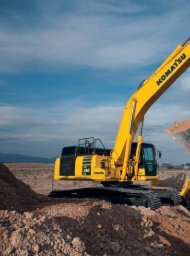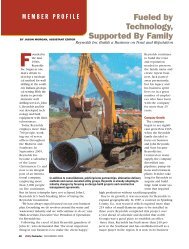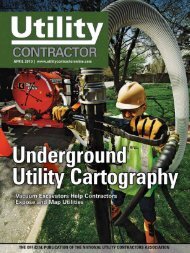View Full August PDF Issue - Utility Contractor Online
View Full August PDF Issue - Utility Contractor Online
View Full August PDF Issue - Utility Contractor Online
- No tags were found...
You also want an ePaper? Increase the reach of your titles
YUMPU automatically turns print PDFs into web optimized ePapers that Google loves.
Boring UnitsAnother popular attachment for installing utility linesis the boring unit. When contractors are faced with placingutility lines in areas where they’re unable to trench orplow, many of them turn to the boring unit. This attachmentenables them to place service lines under sidewalks,driveways and other structures.Bobcat’s boring unit can install pipe as large as 3 in. indiameter up to a maximum distance of about 25 ft. So howdoes this unique attachment work? Well, Odegaard says ascrew-type boring bit is driven through the ground as themachine is driven forward. As this happens, the ground iscompacted outward to create a tunnel under the obstacle.“Once the boring bit reaches the other side, a reamingbit is then installed and the utility line is connected to theswivel on the reaming bit,” he explains. “The machine isthen backed up and the rotating reamer bit further compactsthe soil as it pulls the utility line through theenlarged tunnel.”Vibratory PlowsIndustry watchers are seeing more utility contractorsusing vibratory plows mainly because of increased awarenessabout the attachment’s primary benefit — minimalground disturbance to lawns. This efficient attachmentplaces utility lines up to a maximum depth of 18 in. belowground level by slicing a thin blade into the ground andplacing the line directly into the trench with a single pass.“The vibratory plow saves time because unlike thetrencher (where contractors must dig the trench firstbefore installing the line) they can do both at the sametime,” Odegaard says. “Less ground disturbance is hugebecause you don’t have to go back, put the pipe in or levelout the ground you dug up. You’re installing as you go.”With a vibratory plow, you don't have to go back, putthe pipe in or level out the ground you dug up.You're installing as you go.Boring units enable contractors to place service linesunder sidewalks, driveways and other structures.And Many More<strong>Contractor</strong>s can also utilize several other attachmentswith their compact machines to help complete utility installationsfrom start to finish. For example, a combinationbucket can be used to carry or move dirt and rocks and tobackfill trenches. When installing irrigation systems, landscapersmight attach an auger, digger or backhoe to theirloader in order to dig holes for the system’s valve boxes.In heavy soil conditions, landscapers might use anauger attachment to dig deeper holes so that they can thenfill the valve boxes with rock or gravel to allow fordrainage. A backhoe attachment comes in handy whenneeding to reach and dig holes in extremely sensitive areaswhere loaders can’t travel.Once the installation is complete, contractors want toleave the site looking just as good (or better than) whenthey arrived. Attaching an angle broom to a loader allowsyou to sweep dirt, rock and other debris from sidewalks,driveways and parking lots. Other popular accessory-typeattachments include pallet forks for hauling materials, ahydraulic breaker for breaking through rock in difficultsoil conditions, or a stump grinder for cutting and removingtree roots that are in the way of utility lines.<strong>Utility</strong> contractors have several choices when it comesto attachments. But before deciding whether to purchasea trencher, vibratory plow, boring unit or backhoe attachment,Odegaard suggests trying before you buy.“As with any application, contractors should make surethey match the right tool to the job by considering possiblechallenges and whether they’ll be working in mostlynew construction or established areas,” Odegaard says.“A utility contractor will also want to consider what typeof soil conditions are found in the region they’ll be workingin before choosing their installation method.”Tara Deering-Hansen is a technical writer for Two Rivers Marketingin Des Moines, Iowa.30 <strong>Utility</strong> <strong>Contractor</strong> | <strong>August</strong> 2007


